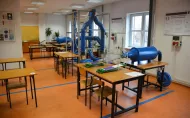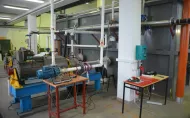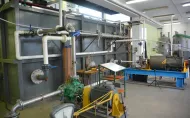Water Machines and Fluid Mechanics
Water Machines and Fluid Mechanics Facility in the Institute of Turbomachinery is managed by dr hab. inż. Krzysztof Sobczak. The members of this facility conduct scientific research in domestic and foreign projects and through industry collaborations. They also teach various full-time and part-time studies subjects, as well as postgraduate and PhD courses, in Polish, English and French languages.
Research of the facility is mainly concentrated on two fields:
Hydraulic machines and devices:
Research in this field is centered around the optimization and modernization of hydraulic machines and devices used in various branches of industry. The base of the studies are the 3D simulations of the flow in hydraulic conduits of vane constructions, using commercial software (i.a. ANSYS CFX) and a variety of optimization algorithms.
In our construction works and modernization of hydraulic systems of pumps intended for industrial use, we incorporate design methods of our own development:
- we are able to adjust the shape of flow characteristics in accordance with the client’s needs.
- incorporate non-overloadable characteristics of power intake.
- adjust the mechanisms for special exploitation and movement requirements using numerical analysis of three-dimensional flow.
Successes with our projects, research and modernization have led to the launch and deployment of several pumps of various types and size.
The faculty has a Water Machines Laboratory measuring 306m2, that contains a free-standing 30 m3 container connected to a 53 m3 depth tank, with a panel that enables the flow of water between the two vessels with simultaneous cooling of that water. The laboratory also has a 0,75 diameter and 14 m deep well tank and isolated power supply of 2 MW power with 6 kV voltage and 365 kW with 400V voltage.
[---]
The laboratory has the following research stations available:
- For measuring the distribution of pressure in rotor chamber of centrifugal pump, that operates by a propulsive electric motor of 1,5 kW power and the rotation frequency of 2950 rotations per minute.
- For measuring the structure of the flow in the semi-open rotors of pumps with low speed differentials and electric engine of 25kW driving power and infinitely adjustable rotation control on the scale of 0÷10000 rotations per minute. Measuring hardware facilitates evaluation of local and non-stationary flow parameters.
- A station for model research of inlet chambers, created in cooperation with ALSTOM Power and used for researching the conditions of inflow to cooling water pumps in 460 MW block of Pątnów II Power Plant.
Aerodynamics and acoustics:
Research id these fields is mainly centered around the functionality of small wind turbines (of horizontal and vertical spin axis) and rotors (especially in drones). The team works on design and optimization of rotor’s geometry using computing codes of our own design and both commercial and non-commercial software (such as ANSYS Fluent). We also perform experiments in subsonic aerodynamic tunnel, equipped with hardware used for pneumatic and thermo-anemometric CTA (Constant Temperature Anemometry) measures and PIV (Particle Image Velocimetry) flow visualization.
Acoustic research is performer in the Institute’s silent chamber, which large plenum enables the studies of acoustic emissions of flow machines (such as rotors) without disrupting their functionality. The chamber is equipped with a data acquisition system with 4 free field microphones and high-quality reference sources with an amplifier and base signal generator for acoustic studies of material samples, in accordance with PN-ISO 10534.
The members of the facility have taken, and are taking part in a multitude of research works on simulation and numerical analysis of:
- - flow in rotating machines such as interactions between stator and rotor, secondary flow, leaks and their interactions with the main flow, transient non-static value, compressors, blowers and ventilators.
- - the streamline of helicopters, vehicles, boats and planes hulls.
- - the flow in thermo-chemical devices, mixers and chemical reactors.
- - the flow in implants and biomedical devices.
- - design and optimization of inlet and discharge channels of helicopter engines.
which have been completed as a solo project of the facility and as a cooperation with other facilities in the University.
Water Machines and Fluid Mechanics Facility is also collaborating with Polish and European research centers: Łukasiewicz Research Network – Institute of Aviation (Warsaw), Hochschule für Technik und Wirtschaft des Saarlandes (Saarbrucken, Germany), Arts et Métiers ParisTech (Paris, France) and Technical University of Sofia (Sofia, Bulgaria). Our collaborations with corporations, in turn, has included such brands as: Airbus Helicopters, SECO/WARWICK, EuRoPol GAZ S.A., PKN ORLEN, Zakład Wodociągów i Kanalizacji w Łodzi, ROSSMANN, ERGOS SP z o.o. and DeveciTech.
The results of our research are published in many scientific journals, industry magazines and official reports. The members of the facility also hold the rights to domestic and international patent rights to their inventions.
The members of this facility teach students on both full-time and part-time studies, and on both first and second cycle studies, of the following subjects: Mechanical Engineering, Power Engineering as a PhD and Interdisciplinary PhD in Mechanical Engineering.
In the Water Machines and Fluid Mechanics Facility there are two study laboratories:
- Water Machines Laboratory with 4 stations for pump diagnostics.
- Fluid Mechanics Laboratory with 14 stations for presentations and research on the basic phenomena from the field of fluid dynamics.
As a part of Water Machines and Fluid Mechanics Facility, there is also a student group: Energists Student Group (SKN Energetyków). The wind turbine made by students as a part of project GUST (Generative Urban Small Turbine) achieved many awards, such as first and second places in ISWTC small wind turbine contest in the Netherlands, KOKOS Award or Lodz Eureka Award. The group is a part of „Najlepsi z Najlepszych!” (The Best of the Best!) and „Studenckie Koła Naukowe Tworzą Innowacje” (Students Groups Toward Innovation) projects.
Members of the WM&FMF:
dr hab. inż. Krzysztof Sobczak, university professor - kierownik
dr hab. inż. Adam Papierski
dr inz. Michał Kulak
dr inż. Michał Lipian
dr Tomasz Wajman



